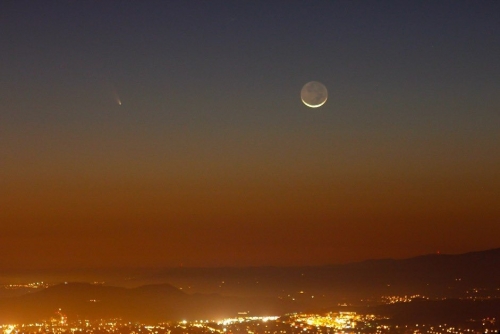Crescent Moon of Shawwal Impossible to Sight on March 29, Confirms International Astronomy Centre
TDT | Manama
Email : ashen@newsofbahrain.com
The majority of countries will attempt to sight the crescent moon of Shawwal (Eid Al-Fitr 1446 AH) on Saturday, March 29, 2025. However, the International Astronomy Centre has confirmed that moon sighting on this day will be impossible in the eastern parts of the world and unfeasible across the rest of the Arab and Islamic world, even with advanced observation tools such as telescopes and astronomical imaging technology. The only possible sightings—albeit with extreme difficulty—will be in central and northern parts of the Americas using telescopes. The crescent may only be visible to the naked eye in areas over the Pacific Ocean west of the United States.
Surface calculations of the crescent's position at sunset on March 29 in various cities indicate the following:
In Jakarta, the moon will set six minutes before sunset, making its sighting impossible in Indonesia and surrounding areas.
In Muscat, the moon will set five minutes after sunset, with an age of one hour and 48 minutes and only 1.5 degrees of separation from the sun.
In Mecca, the moon will set eight minutes after sunset, with an age of three hours and 28 minutes and 2.2 degrees of separation from the sun.
In Amman and Jerusalem, the moon will set 11 minutes after sunset, with an age of three hours and 55 minutes and 2.3 degrees of separation from the sun.
In Cairo, the moon will set 11 minutes after sunset, with an age of four hours and 17 minutes and 2.4 degrees of separation from the sun.
In Rabat, the moon will set 19 minutes after sunset, with an age of eight hours and five minutes and 3.8 degrees of separation from the sun.
In Amsterdam, the moon will set 24 minutes after sunset, with an age of six hours and 49 minutes and 3.5 degrees of separation from the sun.
These conditions indicate that crescent sighting will not be possible in any of these locations, even with telescopes. The calculations also align with established astronomical standards, including the "Danjon Limit," which states that a moon cannot be seen if its angular separation from the sun is less than seven degrees.
According to global sighting criteria, including those established by experts such as Malaysian astronomer Elias, former Greenwich Observatory director Yallop, and the South African Astronomical Observatory, the crescent moon will not be visible on March 29. Even the latest CCD camera imaging technology, capable of detecting the moon in daylight, will be ineffective, as the crescent’s separation from the sun will range between 1.5 and 3 degrees—far below the minimum threshold for visibility.
Additionally, a partial solar eclipse will occur on March 29, visible in parts of western Arab nations such as Mauritania, Morocco, Algeria, and Tunisia. This visible solar event serves as further confirmation that the crescent moon will not be observable on that day or in the hours following.
Given these astronomical findings, countries that require a confirmed moon sighting to declare the end of Ramadan will likely observe a 30-day Ramadan, making Eid Al-Fitr fall on Monday, March 31. However, some nations may declare Eid on Sunday, March 30, based on traditional practices where the new month is announced if conjunction occurs before sunset and the moon sets after the sun in parts of the Islamic world.
Experts caution against potential false moon sighting reports on March 29, emphasizing that any such claims would be scientifically unfounded based on rigorous astronomical evidence.
Related Posts



